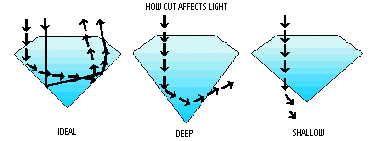The 4 C's of Diamonds
The simplest way to explain diamonds is the Four C's- Cut, Clarity, Color, and Carat Weight. These four properties describe each diamond's unique characteristics. The combination of these values not only determines the rarity (value), but indicates particular characteristics unique to each diamond.
Cut
This refers to the specific proportions of the diamond. The brilliance of a diamond rests upon the way light reflects and refracts from the gem. A well cut stone will refract light down through the stone and back up to the viewer giving the brilliance and scintillation associated with this beautiful gem. Deep stones will not only appear smaller for their weight, but will have a darker appearance. Shallow stones will lose much of their brilliance and often look like glass. The more properly proportioned the diamond, the greater the percentage of light will reflect back through the top.


The table size is referred to as the percentage of the girdle diameter. Today, table sizes are normally 55% to 65% of the girdle diameter with 58% considered the "ideal". The table size and proportions of the stone determine the brilliance of the stone.
Consider the overall symmetry of the stone. If the diamond is being purchased for the sole purpose of enjoyment it should have overall qualities that you will enjoy for a lifetime.
Color
There are three basic components of color grading being hue, tone and saturation. Hue is the basic sensation of color, tone is the degree of lightness or darkness of a hue, and saturation is the intensity or strength of a hue.

The G.I.A. color scale begins with D (colorless) and runs to Z (light yellow). Diamonds that are graded D, E, & F are considered colorless and are very rare. Most diamonds are commonly found with some slight tints of yellow, brown or gray. It can be so slight as to be nearly imperceptible to the untrained eye.
Clarity
Clarity refers to the absence of inclusions and blemishes found in diamonds. Few things in nature are flawless, and diamonds are no exception. When diamonds were crystallized in the depths of the earth, most are formed with inclusions like bubbles, foreign crystals, etc. These minute inclusions were naturally formed and are part of each diamonds uniqueness. The degree to which such inclusions interfere with the passage of light through the diamond, effects the rarity, beauty and the quality of a diamond.
According to the G.I.A. the following is a list of grades used for clarity grading:
- FL-(Flawless) No inclusions or blemishes of any sort when examined under 10x magnification. IF-(Internally Flawless) Stones showing no inclusions and only slight blemishes under 10x magnification.
- VVS1 and VVS2-(Very, Very Slightly included) Stone showing only minute inclusions that are very difficult to see under 10x magnification.
- VS1 and VS2-(Very Slightly Included) Stones showing minor inclusions or pinpoints difficult to see under 10 x magnification.
- SI1 and SI2-(Slightly Included) Noticeable inclusions, easy to see under 10x magnification, usually eye-clean face up.
- I1, I2 and I3-(Imperfect) Obvious inclusions under 10x magnification. Can be seen with the naked eye.
Carat Weight
The weight of diamonds, as in all precious stones, is expressed in "Carats". The word originated from the carob seed, which was used as a gem weight in ancient times.
Because a fraction of a carat could mean hundreds of dollars, a diamond is weighed to a thousandth of a carat and rounded to the nearest hundredth or point. One carat, or 0.20 (1/5)grams, is divided into 100 points. A half carat diamond weighs 50 points and a quarter carat diamond weighs 25 points.
A diamond weighing one carat will be more valuable than a one carat total weight of smaller stones. Larger diamonds are much more rare and therefore are more costly. As the weight of a diamond increases so will the price when cut, color, and clarity are equal.

